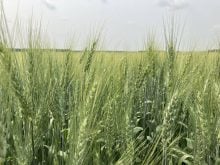Above average rainfall across most of the Prairies has led to excellent rangeland grazing conditions.
However, ranchers in northwestern Alberta, where drought is still occurring, would say otherwise.
Litter is an insurance policy in this situation, said Chris Nykoluk, range management specialist with Agriculture Canada’s agri-environment services branch.
The leftover vegetation that lies on top of the soil but under the new growth is an important component of a healthy range.
Nykoluk told participants at a June workshop that litter cools the soil surface and slows moisture loss. The temperature difference between sites with litter and sites without can be six to 10 C.
Read Also

Why feds imposed EV tariffs
Moe and Kinew have a fight on their hands when it comes to eliminating the EV tariff. Canada has to worry about pissing off the U.S. and Mexico and hundreds of thousands of auto workers.
“Native pasture is usually a lot cooler than tame pasture,” she said.
Native plant litter also breaks down faster than tame grass.
The amount of litter can affect grass growth because moisture is the most limiting factor in pasture productivity. Too much litter can smother new plants, while too little will allow invasive plants to move in and moisture to evaporate.
Research has shown that forage yields in mixed grass prairie drop by 50 percent in dry years when there is no litter.
Producers who want to estimate how much litter they have can perform a simple hand rake assessment by placing a square frame with 50 centimetre sides on a representative area of the range.
Nykoluk said it can be a steel or wood frame or four spikes placed at the corners with string connecting them to form a square.
Rake up litter within the square by hand and compare that amount with pictures contained in a rangeland health assessment book. Alberta and Saskatchewan have produced workbooks to help producers do this.
The process should be repeated at several sites within a field to get a good idea of the conditions.
The litter threshold is 400 pounds per acre for tame grass and 390 lb. per acre for native grass, depending onthe soil zone.
“Different soils have different abilities to produce forage,” she said.
Producers should aim for at least 65 percent of normal litter thresholds. For example, if the goal is 400 lb. per acre, the field should have at least 260 lb. per acre to maintain pasture health.
Stocking rates can affect how much litter is left on a field. It’s important to leave some over the winter to help boost productivity the next year.
Research in Alberta has found that the old “take half, leave half” adage wouldn’t leave enough litter on most fields.
Nykoluk said drought has made producers much more aware of litter’s role in the last five years.
Producers in the wet areas of the Prairies should view this year as one in which pastures will recharge and prepare for the next dry spell.
“This allows them to get a little boost,” she said. “This is productivity that can become litter.”
She reminded producers to practice rotational grazing and pay attention to pasture health.















